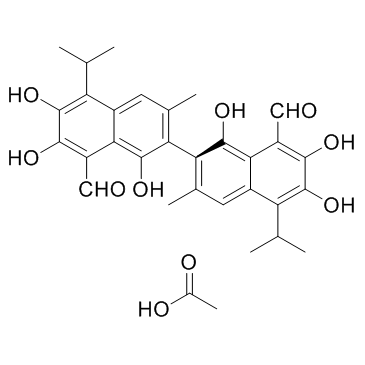
AT-101
CAS No. 866541-93-7
AT-101( R)-(-)-Gossypol acetic acid | (-)-Gossypol acetic acid )
Catalog No. M16298 CAS No. 866541-93-7
A natural phenol that permeates cells and acts as an inhibitor for several dehydrogenase enzymes such as lactate dehydrogenase, NAD-linked enzymes.
Purity : >98% (HPLC)
 COA
COA
 Datasheet
Datasheet
 HNMR
HNMR
 HPLC
HPLC
 MSDS
MSDS
 Handing Instructions
Handing Instructions
| Size | Price / USD | Stock | Quantity |
| 5MG | 50 | In Stock |


|
| 10MG | 92 | In Stock |


|
| 25MG | 203 | In Stock |


|
| 50MG | 365 | In Stock |


|
| 100MG | 531 | In Stock |


|
| 500MG | 1152 | In Stock |


|
| 1G | Get Quote | In Stock |


|
Biological Information
-
Product NameAT-101
-
NoteResearch use only, not for human use.
-
Brief DescriptionA natural phenol that permeates cells and acts as an inhibitor for several dehydrogenase enzymes such as lactate dehydrogenase, NAD-linked enzymes.
-
DescriptionA natural phenol that permeates cells and acts as an inhibitor for several dehydrogenase enzymes such as lactate dehydrogenase, NAD-linked enzymes; a BH3 mimetic that binds and antagonizes anti-apoptotic effect of Bcl-2 family proteins, inhibits tumor growth in Wus1-bearing mice.Blood Cancer Phase 2 Clinical(In Vitro):The natural racemic Gossypol has two enantiomers, namely the (R)-(-)-Gossypol acetic acid (AT-101 (acetic acid)) and (+)-Gossypol enantiomers. (R)-(-)-Gossypol (AT-101) and (+)-Gossypol binds to Bcl-2 or Bcl-xL with similar binding affinities, AT-101 is more potent than (+)-Gossypol in inhibition of cell growth and induction of apoptosis, possibly due to the influence of serum in the cell culture experiments. The racemic form and each of the enantiomers of Gossypol are tested against UM-SCC-6 and UM-SCC-14A in 6-day MTT assays. (R)-(-)-Gossypol (AT-101) exhibits greater growth inhibition relative to (±)-Gossypol than (+)-Gossypol in both cell lines tested (P<0.001). An intermediate growth inhibitory effect is observed with (±)-Gossypol but this effect is only observed at the higher dose of Gossypol (10 μM, P<0.0001). (R)-(-)-Gossypol (AT-101) binds to the BH3-binding groove of Bcl-xL and Bcl-2 proteins with fairly high affinity, has potent activity against head and neck squamous cell carcinomas (HNSCC) cell lines in vitro. Furthermore, it induces apoptosis with high efficiency in HNSCC tumor cells that express functional p53 and that also kills tumor cells with mutant p53 by a different mechanism. (R)-(-)-Gossypol (AT-101) doses required to inhibit the growth of human fibroblast cell lines by 50% were 2- to 10-fold higher than for HNSCC cell lines. To inhibit human oral keratinocyte growth by 50%, (R)-(-)-Gossypol (AT-101) concentrations are 2-to 3-fold higher than for HNSCC cell lines. (R)-(-)-Gossypol (AT-101) causes dose-dependent inhibition of cell growth in ten UM-SCC cell lines over a range from 0.5 to 10 μM in a 6-day MTT assay. The relative sensitivity of the cell lines vary from a very sensitive group with an IC50 of 2-5 μM and a less sensitive group with IC50 clusters around 10 μM. (R)-(-)-Gossypol (AT-101) is determined to bind to Bcl-2, Mcl-1 and Bcl-xL proteins with Ki values of 260±30 nM, 170±10 nM, and 480±40 nM, respectively.
-
In VitroThe natural racemic Gossypol has two enantiomers, namely the (R)-(-)-Gossypol acetic acid (AT-101 (acetic acid)) and (+)-Gossypol enantiomers. (R)-(-)-Gossypol (AT-101) and (+)-Gossypol binds to Bcl-2 or Bcl-xL with similar binding affinities, AT-101 is more potent than (+)-Gossypol in inhibition of cell growth and induction of apoptosis, possibly due to the influence of serum in the cell culture experiments. The racemic form and each of the enantiomers of Gossypol are tested against UM-SCC-6 and UM-SCC-14A in 6-day MTT assays. (R)-(-)-Gossypol (AT-101) exhibits greater growth inhibition relative to (±)-Gossypol than (+)-Gossypol in both cell lines tested (P<0.001). An intermediate growth inhibitory effect is observed with (±)-Gossypol but this effect is only observed at the higher dose of Gossypol (10 μM, P<0.0001). (R)-(-)-Gossypol (AT-101) binds to the BH3-binding groove of Bcl-xL and Bcl-2 proteins with fairly high affinity, has potent activity against head and neck squamous cell carcinomas (HNSCC) cell lines in vitro. Furthermore, it induces apoptosis with high efficiency in HNSCC tumor cells that express functional p53 and that also kills tumor cells with mutant p53 by a different mechanism. (R)-(-)-Gossypol (AT-101) doses required to inhibit the growth of human fibroblast cell lines by 50% were 2- to 10-fold higher than for HNSCC cell lines. To inhibit human oral keratinocyte growth by 50%, (R)-(-)-Gossypol (AT-101) concentrations are 2-to 3-fold higher than for HNSCC cell lines. (R)-(-)-Gossypol (AT-101) causes dose-dependent inhibition of cell growth in ten UM-SCC cell lines over a range from 0.5 to 10 μM in a 6-day MTT assay. The relative sensitivity of the cell lines vary from a very sensitive group with an IC50 of 2-5 μM and a less sensitive group with IC50 clusters around 10 μM. (R)-(-)-Gossypol (AT-101) is determined to bind to Bcl-2, Mcl-1 and Bcl-xL proteins with Ki values of 260±30 nM, 170±10 nM, and 480±40 nM, respectively.
-
In Vivo——
-
SynonymsR)-(-)-Gossypol acetic acid | (-)-Gossypol acetic acid
-
PathwayAngiogenesis
-
TargetBcl-2
-
RecptorBcl-2|Bcl-xL|Mcl-1
-
Research AreaCancer
-
IndicationBlood cancer
Chemical Information
-
CAS Number866541-93-7
-
Formula Weight578.6064
-
Molecular FormulaC32H34O10
-
Purity>98% (HPLC)
-
SolubilityDMSO; Methanol: 7.75 mg/mL
-
SMILESCC1=CC2=C(C(=C(C(=C2C(C)C)O)O)C=O)C(=C1C3=C(C4=C(C=C3C)C(=C(C(=C4C=O)O)O)C(C)C)O)O.CC(=O)O
-
Chemical Name[2,2'-Binaphthalene]-8,8'-dicarboxaldehyde, 1,1',6,6',7,7'-hexahydroxy-3,3'-dimethyl-5,5'-bis(1-methylethyl)-, (2R)-, compd. with acetic acid (1:1)
Shipping & Storage Information
-
Storage(-20℃)
-
ShippingWith Ice Pack
-
Stability≥ 2 years
Reference
1. Lin J, et al. Oncol Rep. 2013 Aug;30(2):731-8.
2. Ciereszko A, et al. Aquat Toxicol, 2000,49(3):181-187.
3. Ferdek PE, et al. Cell Death Dis. 2017 Mar 2;8(3):e2640.
molnova catalog



related products
-
S55746 hydrochloride
S55746 (BCL201, Servier-1) is a novel potent, selective, orally bioavailable inhibitor of BCL-2 with Ki of 1.3 nM.
-
Orobol
Orobol is an inhibitor of tyrosine-specific protein kinase and phosphatidylinositol turnover. Orobol inhibits PI3K isoforms with IC50s of 3.46-5.27 μM for PI3K α/β/γ/K/δ. Orobol exhibits anti-skin-aging and anti-obesity effects.
-
Maritoclax
Maritoclax (Marinopyrrole A) is a novel and specific Mcl-1 inhibitor.



 Cart
Cart
 sales@molnova.com
sales@molnova.com


